Real-world analytics have a significant impact on the drug development process as well as other business processes within healthcare and life science organizations. As data gathered from real-world evidence is increasingly used to inform clinical decision-making, real-world analytics will play an important role in the development and launch of new drugs. Let’s discuss the different types of real-world analytics, how they impact healthcare and pharmaceutical organizations, their impact on operations, and how companies should seek to integrate them into their workflows.
What is the difference between real-world data and real-world analytics?
Real-world evidence (RWE) or real-world data (RWD) is defined as “the data relating to patient health status and/or the delivery of health care routinely collected from a variety of sources.” Sources of RWD include:
- Electronic health records (EHRs)
- Claims and billing activity
- Product and disease registries
- Data gathered from other sources such as mobile devices, wearables such as pedometers and smart watches, etc.
Real-world analytics refers to the use of data to get insights that guide decision-making. This may include the collection and analysis of data from electronic health records (EHRs), claims data, patient-generated data, and other sources. Healthcare and life science organizations use real-world analytics to improve patient outcomes, lower costs, increase operational efficiency, and inform other critical decisions.
In the pharmaceutical industry, real-world analytics are used in:
- Clinical trial design
- Drug safety monitoring
- Demonstrating to regulatory bodies the need for new treatments
- Identifying patient segments with unaddressed needs
- Demonstrating the status of a drug as an orphan drug
What are the different types of RWE analytics?
Healthcare and life science organizations use several types of real-world analytics across all parts of the organization. Different types include:
- Clinical – using patient data to improve clinical outcomes
- Patient – analyzing patient data to improve patient engagement and satisfaction
- Outcomes – measuring and improving the effectiveness of treatments and interventions
- Population health – analyzing data to improve public health and lower healthcare costs
- Financial – using data to reduce costs and increase revenue
- Operational – improving business efficiency and productivity
- Supply chain – optimizing the delivery of products and services
What is the impact?
There are several key impact areas for the different types of real-world analytics in the healthcare and life science industries.
Precision medicine
One of the key impact areas for RWE analytics is in precision medicine, in which targeted therapies are developed to improve outcomes in specific patient populations.
Product differentiation
Drug manufacturers may also rely on RWE analytics to obtain fair reimbursement from payers, something that is increasingly important as competition increases. RWE can help pharma companies differentiate their treatment from similar products offered by competitors.
Postmarket study design
Typically, new drug approval is based on traditional randomized clinical trials (RCTs), which mandate eligibility for patient inclusion. In this methodology, some patients may be excluded – but RWE analytics can provide insights on patients who were excluded in the clinical trial stage.
Using real-world evidence and analytics
To embed RWE across the enterprise, Deloitte recommends:
- Set an enterprise-wide strategy and frequently revisit it to change how RWE is used
- Continue to invest in RWE capabilities given the pace of technological change, availability of new data sources, and demand for talent
- Integrate RWE into relevant processes, such as clinical operations or commercial analytics across the drug life cycle, wherever possible
- Create enterprise governance to ensure that stakeholders have access to RWD for the right purpose.
- As AI-enabled RWE generation grows, define governance to manage the ethical risks associated with AI use.
- Encourage teams to experiment, gain hands-on experience, learn, and iterate with RWD/E to potentially spark new ideas
The challenge of real-world analytics
As organizations use more RWE to help them make strategic decisions, they may find themselves dealing with an overwhelming amount of data. And while having a lot of information to work with is a good thing, pulling relevant observations out of large amounts of unstructured data is time-consuming.
The answer? Technology, of course – particularly tools that use artificial intelligence, natural language processing, and sentiment analysis to help pharma teams find insights quickly.
For life science companies, this functionality is typically found within an insights management platform that consolidates key aspects of the insights generation function: disease community knowledge, influencer mapping, social media listening, live or virtual discussions, and field observations. By reducing the number of systems in which big data and observations are stored and analyzed, pharma teams can make decisions based on a wider array of insights collected over a longer period of time, creating a more objective and reliable scientific narrative.
Learn more about how to get started with an insights management platform.






